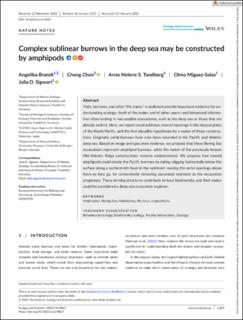| dc.contributor.author | Brandt, Angelika | |
| dc.contributor.author | Chen, Chong | |
| dc.contributor.author | Tandberg, Anne Helene S. | |
| dc.contributor.author | Miguez-Salas, Olmo | |
| dc.contributor.author | Sigwart, Julia D. | |
| dc.date.accessioned | 2023-04-19T08:55:36Z | |
| dc.date.available | 2023-04-19T08:55:36Z | |
| dc.date.created | 2023-03-16T18:44:50Z | |
| dc.date.issued | 2023 | |
| dc.identifier.issn | 2045-7758 | |
| dc.identifier.uri | https://hdl.handle.net/11250/3063748 | |
| dc.description.abstract | Trails, burrows, and other “life traces” in sediment provide important evidence for understanding ecology—both of the maker and of other users—and behavioral information often lacking in inaccessible ecosystems, such as the deep sea or those that are already extinct. Here, we report novel sublinear rows of openings in the abyssal plains of the North Pacific, and the first plausible hypothesis for a maker of these constructions. Enigmatic serial burrows have now been recorded in the Pacific and Atlantic deep sea. Based on image and specimen evidence, we propose that these Bering Sea excavations represent amphipod burrows, while the maker of the previously known Mid-Atlantic Ridge constructions remains undetermined. We propose that maerid amphipods could create the Pacific burrows by eating–digging horizontally below the surface along a nutrient-rich layer in the sediment, making the serial openings above them as they go, for conveniently removing excavated sediment as the excavation progresses. These striking structures contribute to local biodiversity, and their maker could be considered a deep-sea ecosystem engineer. | en_US |
| dc.language.iso | eng | en_US |
| dc.publisher | Wiley | en_US |
| dc.rights | Navngivelse 4.0 Internasjonal | * |
| dc.rights.uri | http://creativecommons.org/licenses/by/4.0/deed.no | * |
| dc.title | Complex sublinear burrows in the deep sea may be constructed by amphipods | en_US |
| dc.type | Journal article | en_US |
| dc.type | Peer reviewed | en_US |
| dc.description.version | publishedVersion | en_US |
| dc.rights.holder | Copyright 2023 The Author(s) | en_US |
| dc.source.articlenumber | e9867 | en_US |
| cristin.ispublished | true | |
| cristin.fulltext | original | |
| cristin.qualitycode | 1 | |
| dc.identifier.doi | 10.1002/ece3.9867 | |
| dc.identifier.cristin | 2134583 | |
| dc.source.journal | Ecology and Evolution | en_US |
| dc.identifier.citation | Ecology and Evolution. 2023, 13 (3), e9867. | en_US |
| dc.source.volume | 13 | en_US |
| dc.source.issue | 3 | en_US |

